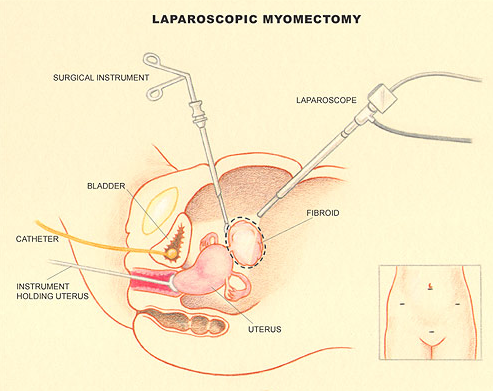Laparoscopic Myomectomy
Laparoscopic Myomectomy is a surgical operation used to remove fibroids using small abdominal incisions. For people experiencing troubles as a result of fibroids, laparoscopic myomectomy is proposed and advised. When a woman wants the fibroids removed but wants to keep her uterus this surgery is frequently advised. Fibroids have an impact on daily life because they produce issues such as pelvic pain or pressure, heavy menstrual bleeding, urine frequency, or incontinence.
Why is a Laparoscopic Myomectomy performed?
If you have many reasons and symptoms that interfere with your daily activities, such as heavy menstrual flow, pelvic pressure, or urinary incontinence, doctors may recommend laparoscopic myomectomy. If the uterine fibroids are interfering with fertility, they should be removed by this procedure.

When should a laparoscopic myomectomy be performed?
When the largest fibroid is less than 10cm in size and the overall number of fibroids is less than 5, this surgery is considered. However, depending on the conditions, larger and more numerous fibroids can sometimes be eliminated this way. In general, a laparoscopic method is chosen if the projected time of surgery is shorter than three hours. It can also be utilised as a two or three-stage process at times. To make the surgery easier, certain hormone injections or tablets might be administered to minimise the size of the fibroids.Procedure
The operation begins with anaesthetic, followed by four minor incisions made by the physician. In the lower belly, these incisions are about half an inch long each. The abdomen is filled with carbon dioxide gas, allowing the surgeon to view inside. The gynecologist inserts a laparoscope through one of the incisions. A laparoscope is simply a bright light narrow tube with a camera connected to one end. Small instruments are inserted into the other incision.
In the instance of robotic-assisted laparoscopic surgery, the instruments are controlled remotely with a robotic arm. The surgeon will break the fibroids into little pieces in order to remove them from the uterus. If the fibroids are excessively large, abdominal myomectomy is utilised, which involves making major incisions in the belly to remove the fibroids. The fibroids are forced out of the vaginal or abdominal apertures. After removing the fibroids, the surgeon will remove the instruments, release the gas, and close the incision.
Benefits of Laparoscopic myomectomy
Laparoscopic myomectomy has several advantages over open abdominal surgery, including:
Improved recovery
Short hospital stay
Reduced adhesions Scar that has been cosmetically improved
Recovery time after Laparoscopic myomectomy
You will be hospitalised for 24-48 hours depending on recovery. You may experience some discomfort, particularly when moving, but this will be well-controlled by analgesia. You may experience minor vaginal bleeding as well as shoulder ache. You will be tired, but you will be able to eat and drink regularly, walk about, and use the restroom. After 24-48 hours, you will be discharged from the hospital. The doctor recommends using regular pain relievers for the first three days after discharge. You could go for short walks, bath and shower as usual, and avoid heavy lifting. You should also take enough rest after this procedure. At the completion of the first week, you will be seen for a postoperative review and suture removal.
DR.ANSHUMALA SHUKLA is the leading gynecologist in Mumbai who is expertise in treating all kinds of infertility problems. Book your appointment today.
